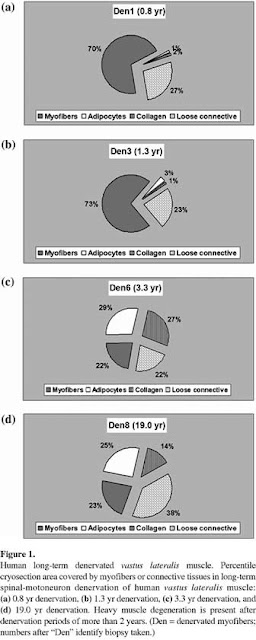Hello again!
Just came across something very interesting and decided to write a quick update on our previous blog.
We found a newer study done by Ashley et al (2008) that is sure to keep past researchers on their toes. The study used 5 different stimulation patterns with a range of parameters on chronically denervated muscles of a rabbit (patterns shown in table below). This study was interesting b/c they did use subcutaneous electrodes, which can stimulate without as much resistance from connective tissue or fat.

We know you are thinking.. So what does that table mean?
All of these diverse parameters were shown to restore muscle fiber size and function with little to no difference between the different patterns. This study does support rectangular pulsed currents, but also shows that even varying parameters can regenerate the muscle to a certain amount. We think this can be helpful because it means that a person who has a busy daily life might be more compliant if they don’t have to take as much time or spend multiple times a day on estim, and can still get the same result.
So it sounds like a lot of work.. how many months/years does the patient need to stimulate for?
Another good point that we thought Ashley et al made is that the patient has to keep with it. If they stop the stimulation, the muscle will atrophy again! The time spent doing this can be worth it, due to the fact that it can keep them out of the hospital more, as well as improve daily activities and overall health, but it also depends on the patient and how willing they are to keep with it.
Sounds eccentric and dangerous.. Is this safe?
This study was also very useful to demonstrate that no matter how long or how often, the stimulation is safe. While no parameters have been found in previous research that have been limiting, the extent that the 4th pattern goes to helps to show how safe the stimulation is.
We know, this is contradictory, we told you one thing and now we are thinking another, but that’s the way the cookie crumbles with this topic! Keep in mind though that this study was done with subcutaneous electrodes, so we don't know if these principles apply to surface electrodes as well. Further research tells us the important parameters of estim are not agreed upon among practitioners (Eberstein & Eberstein, 1996). It is quite controversial what is correct and most effective, so we thought we would give you all the info and let you chew on it for awhile. We will be back with more stimulation for you very soon. Until next time! J
Team North America Signing off-
-Megs and Brooke
Reference
Ashley, Z., Sutherland, H., Russold, M.F., Lanmüller, H., Mayr, W., Jarvis, J.C., & Salmons, S. (2008). Therapeutic stimulation of denervated muscles: the influence of pattern. Muscle Nerve. 38(1):875-68
